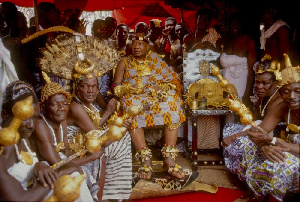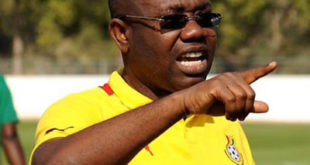Being the young, ambitious legal brain he was at the time, he must have only had his eyes fixed on building a career and a name for himself but with the death of his uncle, Prempeh II, all his dreams of a private life became perpetually shelved.
Before this, the Asantehene, Otumfuo Opoku Ware II, had been named ambassador to Italy, but when his uncle died, his legal and political successes made him a perfect candidate to be named as the successor of the throne.
As King, Opoku Ware II is reported to have maintained a good relationship with the country’s presidents who ruled during his time: Ignatius Kutu Acheampong, and later Flt. Lt. Jerry John Rawlings.
Otumfuo Opoku Ware II was the 15th Asantehene, ruling between 1970 and February 1999 (29) when he died but what was his life really like?
In this GhanaWeb series, we put the spotlight on the life of the Asante monarch who ruled before the current one, Otumfuo Nana Osei Tutu II, and some of the things that characterized his life.
Early life and education
Born Jacob Matthew Poku in Kumasi in 1919 into the Ashanti royal family, he became one of the several candidates to succeed the throne, only after the demise of Prempeh II.
As tradition required, this was to be decided by the Queen Mother, or the Nana Asantehemaa, a report by JudaGh (via Opera News) said.
After attending an Anglican school, Jacob Poku went to Adisadel College in Cape Coast and after working in the public sector for a while, he relocated to the United Kingdom in the 1950s to study law at the Middle Temple.
In 1962, he was admitted to the bar.
Career
Poku worked as a building inspector and later for the Public Works Department of Ghana from 1937 to 1943. After that, he was trained as a surveyor and worked on the Kumasi Traditional Council Hall and Kwame Nkrumah University of Science and Technology.
On his return to Ghana in 1962, after his call to the British bar, he first worked in Accra before setting up a firm in Kumasi.
With diligence as a hallmark, he worked his way up the ladder, earning for himself great respect in Ashanti politics, and as a lawyer of repute.
In 1966, after the coup that overthrew Ghana’s first president, Kwame Nkrumah, the military government of the National Liberation Council appointed Poku to their executive board as Commissioner of Communications (an equivalent of the current Minister of Communications) in 1968.

A Photo of the statue of Opoku Ware II in Kumasi shot by Edem Srem
Reign
In 1970, he was named ambassador to Italy, but shortly thereafter his uncle, the King of the Ashanti, Prempeh II, died. Due to his legal and political successes, he was chosen to succeed the throne and was enthroned as the Asantehene. As King, Opoku Ware II maintained a good relationship with Ghana’s President Ignatius Acheampong, and later Jerry John Rawlings.
He focused on trying to implement the traditional justice of the Ashanti tribe, rather than becoming involved in national politics. Much like his predecessors, he rarely appeared in public and usually had a spokesman represent him. When he did appear, he was, as tradition demands, covered in gold and wore an intricately woven kente cloth.
In 1985, Otumfuo Opoku Ware II created the stool Nkosuostool (Development stool) as a catalyst for development in Kumasi and beyond. Since then, the trend of bestowing the title of nkosuohene or hemaa on notable people in Ghana has gained prominence.
In August 1995, he marked his silver jubilee celebration, representing 25 years of his reign as the Otumfuo.
Personal life and death
In 1945, he married another member of the royal family, Victoria. In 1996, Opoku Ware II’s wife Victoria passed away and a few years after on February 26, 1999, the King himself died.
He was given a state and Ashanti cultural funeral spanning four days that blended both African and Christian traditions.
He was buried on March 25, 1999, after a month of mourning at the Royal Mausoleum. He was succeeded on April 26 by Otumfuo Nana Osei Tutu II after a period of mourning and was survived by his three children: Nana Osei, Gifty (1950-2018) and Leslie Poku.
Source: www.ghanaweb.com
 Home Of Ghana News Ghana News, Entertainment And More
Home Of Ghana News Ghana News, Entertainment And More





